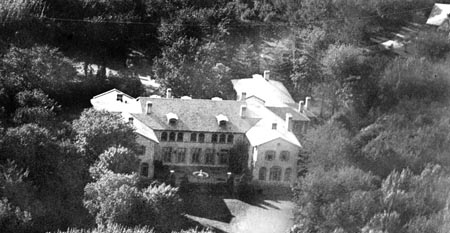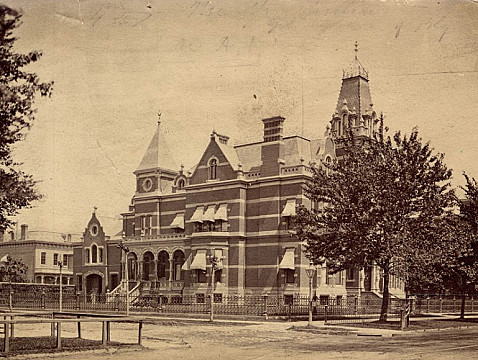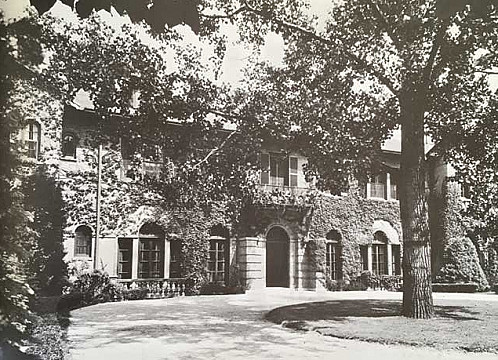Historical Architecture of Grosse Pointe – The Lost Estates – 525 Lakeshore
Posted by
Allan and Elizabeth Shelden owned over a 800 acre estate in Stony Creek Metro Park.Located near the Stony Creek golf course.
Posted by
on Tuesday, April 24th, 2018 at 1:39pm.

This week we continue with our review of the lost estates of Lakeshore with our penultimate post about these wonderful homes.
Last week we reviewed the lost Ford estates, designed by Pittsburgh architect Albert H. Spahr. This week we focus on 525 Lakeshore – one of the largest estates to have ever graced Grosse Pointe – Deeplands, set on a colossal 80 acres. To give you a rough idea on the size of this estate, once the home was demolished and the land sub divided more than 80 homes (of varying sizes) were built on the area. Source: Grosse Pointe 1880-1930 by Madeleine Socia and Suzy Berschback.
Deeplands was built in 1911 for Henry D. Sheldon, and his wife Caroline. They were married in 1887 and had three children. Mr. Sheldon was born in Portville, N.Y in 1862. He attended Yale College in 1886 where he studied law, and was admitted to the Michigan bar in 1887. Between 1887 and 1890 he was involved in the wholesale dry goods business, after which he divided his attention between various corporate boards. He passed away in 1941. Mrs. Caroline Sheldon was a Detroit society leader. She was born in 1865 to General Russell A. Alger, the former Govenor of Michigan and Secretary of War in President McKinley’s cabinet. She was a member of many prominent societies in and around Detroit including the Society of Arts and Crafts, Daughters of the American Revolution, and the Detroit Museum of Arts Founders Society. She passed away in 1935. Source:


The Sheldon’s new home was an opulent mansion in the style of an Italian Villa. The exterior walls were faced with grayish-yellow bricks, while the roof tiles were green. The entrance, approached by a driveway, was at the rear of the house, nestled within an abundance of trees and shrubs. The front of the home faced Lakeshore, and had 1,100 feet of frontage on Lake St. Clair with a portion extending inland by 3,000 feet. Source: Grosse Pointe Historical Society.


The property also included three smaller buildings – a four-car garage, stables and a house for the gardener. Based on research by the Grosse Pointe Historical Society the house was named ‘Deeplands’ because the property extended back into the country.


The interior of the home was stunning, and no expense was spared in creating a luxurious interior for the family, and a fashionable showplace for the Sheldon’s many lavish parties.


Arthur Heun of Chicago designed the home. Mr. Heun was born in Saginaw in 1866. He initially trained in architecture at his uncles’ practice in Grand Rapids. In 1888, when he was 22, Heun moved to Chicago to work as a draftsman for Francis Whitehouse, one of Chicago’s most popular residential architects of that era. Five years later, 1893, Mr. Heun took full control of the practice due to the retirement of the firm’s distinguished owner. By now Arthur Heun had a fine reputation as a residential architect and was highly sought after. His work tended to follow the Prairie school aesthetic similar to his mentors Frank Lloyd Wright and Louis Sullivan.
He created many homes in the Chicago area for prominent residents of the city, along with designing several country estates in the suburb of Lake Forest on the city’s North Shore. His work also included several commercial projects, including the Casino Club, and the Art Club in the city. Mr. Heun was also a skilled designer in the area of decorative arts. Early on in his career he was known for creating decorative glass panels, wall sconces and chandeliers. It is not clear, however, if any of these skills were applied to his work at Deeplands.


It is possible that 525 Lakeshore was Heun’s only project here in Metro Detroit, and certainly Grosse Pointe.
After the death of Mr. Sheldon (in 1941) the house was demolished, and the land was subsequently sub-divided. Sadly all that remains are the two streets named after the original estate – N. Deepland and S. Deeplands – along with the 80 homes that now occupy the original space.
We will be concluding our story of Grosse Pointe’s lost Lakeshore estates next week.
Written by Katie Doelle
Copyright © 2018 Higbie Maxon Agney & Katie Doelle
If you have a home, building or street you would like us to profile please contact Darby Moran –
– we will try and feature the property.

83 Kercheval Grosse Pointe Farms,
MI, 48236
Deeplands Road. Henry D. Shelden House. Named for the
estate of Henry D. Shelden, Built between 1911 a nd 1915. Horse
chestnut trees running south from Deeplands Road fronted the Shelden
property.
nd 1915. Horse
chestnut trees running south from Deeplands Road fronted the Shelden
property.
196 Fort Street West, Detroit, Michigan

Allan Shelden Residence, Detroit
https://digitalcollections.detroitpubliclibrary.org/islandora/object/islandora%3A149307
525 Lake Shore Road, Grosse Pointe, Michigan

Deeplands, 525 Lakeshore Road
 Legendary Locals of Grosse Pointe By Ann Marie Aliotta and Suzy Berschback
Legendary Locals of Grosse Pointe By Ann Marie Aliotta and Suzy Berschback